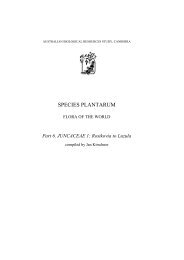Introduction - Species Plantarum Programme
Introduction - Species Plantarum Programme
Introduction - Species Plantarum Programme
You also want an ePaper? Increase the reach of your titles
YUMPU automatically turns print PDFs into web optimized ePapers that Google loves.
16<br />
SPECIES PLANTARUM — FLORA OF THE WORLD (1999)<br />
hypogynous, pedicellate, bracteate. Sepals and petals 5, free, imbricate. Stamens 5, opposite<br />
petals and adnate to them at base; anthers dorsifixed, bilocular, introrse by longitudinal slits;<br />
staminodes 5, alternate with stamens, petaloid, each with a basal depressed-globular nectary.<br />
Ovary superior, 1-locular; ovule 1 on apical placenta, anatropous; styles 1 or 2; stigma<br />
capitate. Fruit a drupe. Seeds without endosperm; embryo straight. [103 words]<br />
A single genus Corynocarpus with c. 6 species, native to eastern Australia, New Guinea,<br />
New Caledonia, New Zealand and Vanuatu.<br />
W.B.Hemsley, On the genus Corynocarpus Forst., with descriptions of two new species,<br />
Ann. Bot. 17: 743–760, t. 36 (1903); C.G.G.J.van Steenis, Corynocarpaceae, Fl. Males. ser.<br />
I, 4: 262–264 (1951); J.Krause, Corynocarpaceae, Nat. Pflanzenfam. 2nd edn, 20b: 22–35<br />
(1960); D.B.Foreman, Corynocarpaceae, Handb. Fl. Papua New Guinea 1: 111–113 (1978).<br />
CORYNOCARPUS<br />
Corynocarpus J.R.Forst. & G.Forst., Char. Gen. Pl. 31, t. 16 (1776).<br />
Type: C. laevigatus J.R.Forst. & G.Forst.<br />
Leaves not aristate, juveniles with entire margins; petals shortly spathulate,<br />
entire; staminodes irregularly lobed 1. C. cribbianus<br />
Leaves aristate, juveniles with spinose margins; petals oblong-spathulate,<br />
minutely fimbriate at apex; staminodes denticulate 2. C. rupestris<br />
(partial key only)<br />
Key to genera<br />
Amended from Fl. Australia 22: 214 (1984)<br />
Next follows the key to genera which is titled as such. Where infrafamilial taxa are<br />
recognised and described, genera in each may be keyed separately. Where no infrafamilial<br />
ranks are used, or where it is more convenient to do so, the key to genera may follow directly<br />
after the family treatment. The key to genera is intended primarily as an aid in identification<br />
and therefore should be as simple as possible. In the Solanaceae (Fl. Australia 29: 3–5,<br />
1982), note that many of the leads are of only one or two lines of text. It is quite acceptable<br />
for variable taxa to be keyed out in more than one place, as for example Nicotiana in this<br />
key.<br />
In constructing the key the most important consideration is workability. It should be tested<br />
with as many species as possible, in particular to ensure that the user does not finish up at a<br />
dead end or have to choose for or against a character that has already been chosen against.<br />
As far as possible, especially in large keys, the early couplets should be used to divide the<br />
major parts of a key into more or less equal-sized groups of taxa. This prevents a key<br />
becoming indented too far to the right.<br />
Sometimes it will be valuable to have more than one key to genera, as for example if the<br />
included species are dioecious. The Cucurbitaceae are such a case, with separate keys based<br />
on male and female plants.<br />
KEY TO GENERA BASED ON MALE FLOWERS<br />
1 Male flowers in panicles, rarely racemes; stamens 5, free, inserted on<br />
disc 1. NEOALSOMITRA<br />
1: Male flowers not in panicles (rarely in dichotomous racemes appearing<br />
paniculate); stamens 3, free, coherent or fused, not inserted on disc












